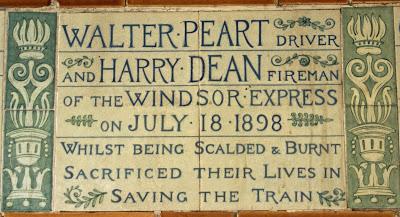 Walter Peart and Henry Dean were the driver and stoker of the Great Western train known as the Windsor Express. On 18 July 1898, they were driving the 4.15 train from Windsor to Paddington on what seemed a routine trip when, just outside Acton, the connecting rod broke. Part of it was driven through the boiler casing and caused damage to the fire box which overwhelmed the men with cinders, steam and fire. Nonetheless, they succeeded in applying the brake and bringing the train to a safe standstill before leaving the engine at Acton Station.
Walter Peart and Henry Dean were the driver and stoker of the Great Western train known as the Windsor Express. On 18 July 1898, they were driving the 4.15 train from Windsor to Paddington on what seemed a routine trip when, just outside Acton, the connecting rod broke. Part of it was driven through the boiler casing and caused damage to the fire box which overwhelmed the men with cinders, steam and fire. Nonetheless, they succeeded in applying the brake and bringing the train to a safe standstill before leaving the engine at Acton Station.At hospital, Peart explained why he hadn't jumped out:
I stopped my engine. ... When it happened, I got back out of the way, and I thought to myself, the train is running as fast as ever. I thought I would go back to the fire and put my vacuum brake on. I did it, and as I got out from the fire and the smoke I couldn't run and when I was by the side of the engine my leg was struck by the connecting rod, which was broken.Among the lives saved by Peart and Dean was that of Mr Goschen, First Lord of the Admiralty, who wrote with a subscription to their families. However, Peart and Dean themselves died of their injuries in St Mary's Hospital. The inquest jury desired 'to place on record their high appreciation of the conduct of the two deceased men in applying the brake and in keeping at their posts, thus averting a very serious catastrophe which would have endangered the lives of the passengers of the train.' Both men left widows, and Peart also had five children.
The plaque in Postman's Park summarises the incident well:
WALTER PEART DRIVER AND HARRY DEAN FIREMAN OF THE WINDSOR EXPRESS ON JULY 18 1898 WHILST BEING SCALDED & BURNT SACRIFICED THEIR LIVES IN SAVING THE TRAIN. It is not their only memorial. The Amalgamated Society of Railway Servants erected a tomb for the two men in Kensal Green Cemetery, featuring a relief of a train and railway tracks. It was restored in 1994, and is Grade-II listed.
Such an act of self-sacrifice by railway employees was not unique. Daniel Pemberton would die at Twickenham in order to save a colleague. They were working on the railway track when an express train approached; Pemberton pushed Thomas Harwood safely out of the way but was himself struck by the engine and killed.
DANIEL PEMBERTON AGED 61 FOREMAN LSWR SURPRISED BY A TRAIN WHEN GAUGING THE LINE HURLED HIS MATE OUT OF THE TRACK SAVING HIS LIFE AT THE COST OF HIS OWN, JAN 17 1903.


